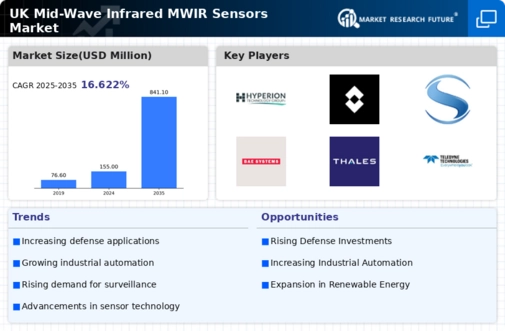The UK Mid-Wave Infrared MWIR Sensors Market is characterized by a dynamic competitive landscape that sees a blend of established players and emerging companies vying for market share in a rapidly evolving technological environment. The increasing demand for MWIR sensors in surveillance, industrial applications, and defense has spurred innovation and strategic collaborations within the sector. Companies are engaged in constant research and development efforts to enhance sensor capabilities, improve performance, and streamline manufacturing processes.
The competitive insights reveal that players are focusing on geographical expansion, product differentiation, and technological advancements to maintain a competitive edge amidst the rising trends toward automation and smart technology integration in various applications.Hyperion Technology Group has established a significant presence in the UK Mid-Wave Infrared MWIR Sensors Market through its commitment to innovation and technological growth. The company showcases a strong reputation for providing high-performance sensors that cater to various applications, including defense, security, and environmental monitoring.
The strengths of Hyperion Technology Group lie in its advanced research and development capabilities, enabling the company to deliver products that meet stringent international standards and customer specifications. Moreover, their strong supply chain management and customer service systems further enhance their market position, allowing them to respond quickly to client needs and market demands, solidifying their competitive stance in the UK MWIR sensors landscape.FLIR Systems is another prominent player in the UK Mid-Wave Infrared MWIR Sensors Market, recognized for its cutting-edge sensor technology and comprehensive product offerings.
The company specializes in producing MWIR sensors that are utilized across diverse sectors, such as military, law enforcement, and industrial processes. FLIR Systems' strengths are highlighted by its strong brand recognition, extensive distribution network, and robust portfolio of products, including thermal imaging and surveillance systems. The UK branch of FLIR Systems is particularly noted for its strategic initiatives, including mergers and acquisitions aimed at enhancing its technological capabilities and expanding its market reach.
The company actively invests in research and development to maintain a competitive advantage while ensuring compliance with regulatory standards, thus reinforcing its commitment to delivering reliable and innovative MWIR sensor solutions within the UK market.


















Leave a Comment